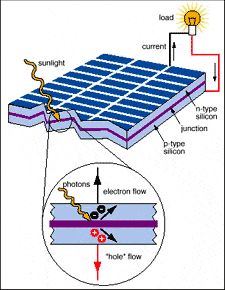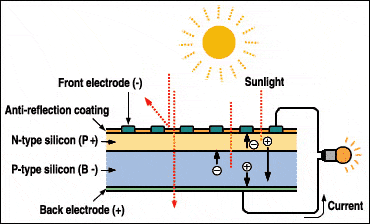Solar
Energynergy
 Solar
technology is cost effective, reliable, and environmentally
sound. Energistx partners with the nation's leading designers,
manufacturers and installers of grid-connected solar electric
systems and kits for off-the-grid systems. We offer a full
line of products including roof-mounted, ground-mounted, and
canopy solar systems for private, industrial, commercial,
and government applications. Join the growing number of forward
thinking individuals, companies and government agencies that
are investing in on-site solar generation and reaping the
many benefits of harnessing the sun's abundant, free energy. Solar
technology is cost effective, reliable, and environmentally
sound. Energistx partners with the nation's leading designers,
manufacturers and installers of grid-connected solar electric
systems and kits for off-the-grid systems. We offer a full
line of products including roof-mounted, ground-mounted, and
canopy solar systems for private, industrial, commercial,
and government applications. Join the growing number of forward
thinking individuals, companies and government agencies that
are investing in on-site solar generation and reaping the
many benefits of harnessing the sun's abundant, free energy.
attention!If
you are a manufacturer and have a portable ( user installed)
integrated product or package that is ready for market, we
feel that we have the best exposure on the web for these cutting
edge technologies. Currently, the products offered here are
for large systems that generally need to be installed by specialized
solar contractors. So, if you are ready for market with your
innovative green technology, call Energistx and let's bring
it to the world!
30% Federal Rebate Available for Solar and other renewables and efficiency alternatives !
Click here for more information on STATE and FEDERAL REBATES!

How
Solar Cells Work
Solar cells are converters. They take the
energy from sunlight and convert that energy into another
form of energy, electricity. Solar cells convert sunlight
to electricity without any moving parts, noise, pollution,
radiation, or maintenance. The conversion of sunlight into
electricity is made possible with the special properties of
semiconducting materials.
Semi-Conductors
Most solar cells are made from silicon,
the 14th element. Silicon is a "semi-conductor"
or a "semi-metal," and has properties of both a
metal and an insulator. Atoms in a metal have loosely bound
electrons that easily flow when electrical pressure is applied,
whereas atoms in an insulator have tightly bound electrons
that cannot flow when electric voltage is applied. Atoms in
a semi conducting material bind their electrons tighter than
metals, but they may be manipulated to have conductive properties.
Solar cells are made by joining two types of semiconducting
material: P-type and N-type. P-type semiconductors are manufactured
to contain negative ions, and N-type semiconductors to manufactured
to contain positive ions. The positive and negative ions within
the semiconductor provide the environment necessary for an
electrical current to move through a solar cell.
Sunlight Converted
At the atomic level, light is made of a
stream of pure energy particles, called "photons."
This pure energy flows from the sun and shines on the solar
cell. The photons actually penetrate into the silicon and
randomly strike silicon atoms. When a photon strikes a silicon
atom, it ionizes the atom, giving all its energy to an outer
electron and allowing the outer electron to break free of
the atom. The photon disappears from the universe and all
its energy is now in the form of electron movement energy.
It is the movement of electrons with energy that we call "electric
current."
Sunlight
to Electricity
A typical solar cell consists of a glass cover to seal the
cell, an anti-reflective layer to maximize incoming sunlight,
a front and back contact or electrode, and the semiconductor
layers where the electrons begin and complete their voyages.
The electric current stimulated by sunlight is collected on
the front electrode and travels through a circuit back to
the solar cell via the back electrode.
PV System architecture
Solar cells alone cannot produce usable
power. They need to be interconnected with other system components
that ultimately serve a specific electrical demand, or ‘load’.
PV systems can either be stand-alone, or grid-connected. The
main difference between these two basic types of systems is
that in the latter case, the PV system produces power in parallel
with the electrical utility, and can feed power back into
the utility grid if the onsite load does not use all of the
PV system’s output.
When the sun is shining, the direct current electricity (DC)
from the PV modules is converted to alternating current (AC)
by the power of an electronic inverter, and then fed directly
into the building power distribution system where it supplies
electric power. Any excess solar power is exported to the
utility power grid and any shortfall is made up with electricity
supplied by the grid. During non-sun hours, the building load
is supplied by utility power alone.
Following are the basic components of a PowerLight grid-connected
photovoltaic system, which is illustrated in the diagram above:
PV modules
A number of photovoltaic cells electrically
interconnected and mounted together, usually in a sealed unit
of convenient size for shipping, handling and assembling into
arrays. The term "module" is often used interchangeably
with the term "panel."
Mounting technology/equipment
Used to mount the PV modules in place.
Depending on the application, the PV modules can be mounted
on rooftops, in parking structures, covered reservoirs and
in open fields.
Combiner box
Where the electrical wiring from the PV
modules is joined together in parallel to combine electrical
currents.
Inverter
Converts the DC output of the PV system
into usable AC output that can be fed directly into the building
load.
Transformer
Used to step up or down the voltage emerging
from the inverter to match the required voltage of the onsite
load or the utility interconnection.
Load
The amount of electrical demand used in
the building at any given time.

Photovoltaic Systems
Characteristics
Photovoltaics (PV) were first used commercially
in 1958 to power the Vanguard communications satellite. PV
requires no moving parts and uses the sun as a source of energy.
As a direct result of declining PV prices, practical applications
for solar cells have steadily expanded from space missions
to remote power and personal electronic devices. Since the
mid 1990’s, PV has become a practical source of solar
electric generation in the $800 billion electric power industry.
Although a number of new technologies, including fuel cells
and micro-turbines, can generate electric power in a distributed
or point-of-use fashion, solar electric power offers multiple
benefits:
Reliable and low maintenance
With no moving parts, solar generation
systems reliably power some of the world's most mission critical
applications, from space satellites to microwave stations
in remote and harsh environments.
Modular and scalable
Solar electric generation is highly scalable
and can be deployed in many configurations, from hand-held
devices to large grid-connected systems in urban centers anywhere
in the world.
Zero emissions
Solar power produces no emissions and no
noise. As a result, they can be easily sited in densely populated
urban areas.
Renewable
Solar electric power is a 100% renewable
energy source. Solar electric power systems provide the advantages
of other distributed generation systems without fuel or regular
maintenance requirements.
No fuel or infrastructure
Solar electric power is not dependent on
the existence, development or maintenance of a fuel delivery
infrastructure, nor is it dependent on the cost of fossil
fuels. Thus, it offers electricity users an important hedge
against future fossil fuel price volatility.
Additionally, the power output from a solar electric generation
system is well matched to periods of peak load demand, typically
occurring during hot summer days. This characteristic is increasingly
significant as time-of-day pricing or other variable real
time pricing mechanisms are implemented during periods of
high demand.
Photovoltaic Systems Applications
Today, solar-generated electricity serves people living in
the most isolated spots on earth as well as in the center
of our biggest cities. First used in the space program, PV
systems are now generating electricity to pump water, light
up the night, activate switches, charge batteries, supply
the electric utility grid, and more.
Simple PV Systems
Simple solar electric systems can be used
to power water pumps for irrigation and drinking wells, and
ventilation fans for air cooling. For this reason, the most
simple PV systems use the DC electricity as soon as it is
generated. Basic PV systems have several advantages for the
special jobs they do: the energy is produced where and when
it is needed, small systems under 500 watts weigh less than
150 pounds which makes them easy to transport and install,
and finally, although pumps and fans may require regular maintenance,
the PV modules require only an occasional inspection and cleaning.
PV with Battery Storage
Storing electrical energy makes PV systems
a reliable source of electric power day and night, rain or
shine. PV systems with battery storage are being used all
over the world to power lights, sensors, recording equipment,
switches, appliances, telephones, televisions, and even power
tools. PV systems with batteries can be designed to power
DC or AC equipment.
PV with Generators
When power must always be available, or
when larger amounts of electricity than a PV system alone
can supply are occasionally needed, an electric generator
can work effectively with a PV system to supply the load.
During the day, the PV modules quietly supply daytime energy
needs and charge batteries. If the batteries run low, the
engine generator runs at full power (its most cost- and fuel-efficient
mode of operation) until they are charged. In some systems,
the generator makes up the difference when electrical demand
exceeds the combined output of the PV modules and the batteries.
PV Connected to Utilities
Where utility power is available, a grid-connected
PV system can supply some of the energy needed and use the
utility in place of batteries. Home, government and business
owners are installing PV systems connected to the utility
grid. They do so because they know that the system reduces
the amount of electricity they purchase from the utility each
month. They also realize that PV consumes no fuel and generates
no pollution.
The owner of a grid-connected PV system may even be able to
sell electricity back to the grid each month. This is because
electricity generated by the PV system can be used on site
or fed through a meter into the utility grid. PowerLight’s
solar electric systems are examples of grid-connected solar
electricity.
Utility-Scale Power
Large-scale photovoltaic power plants,
consisting of many PV arrays installed together, can prove
useful to utilities. Utilities can build PV plants much more
quickly than they can build conventional power plants because
the arrays themselves are easy to install and connect together
electrically. Utilities can locate PV plants where they are
most needed in the grid because siting PV arrays is much easier
than siting a conventional power plant. And, unlike conventional
power plants, PV plants can be expanded incrementally as demand
increases. Finally, PV power plants consume no fuel and produce
no air or water pollution while they silently generate electricity.
Hybrid Power Systems
Hybrid systems combine numerous electricity production and
storage pieces to meet the energy demands of a given facility
or community. In addition to PV, engine generators, wind generators,
small hydro plants, and any other source of electrical energy
can be added as needed to meet energy demands and fit the
local geographical and temporal characteristics. These systems
are ideal for remote applications such as communications stations,
military installations, and rural villages.
Applications and
Products
Our associates are manufacturers of solar
water pumps and a wholesale distributor of components for
solar electric power (PV), solar heating and wind electric
systems. We serve off-grid (remote power), grid-connected
(utility tied) power, remote water supply, and more.
Please
contact us: 1-866-733-8686
Download
Consulting Request Form
|


 S
S

